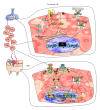Pharmacological overview of galactogogues
- PMID: 25254141
- PMCID: PMC4165197
- DOI: 10.1155/2014/602894
Pharmacological overview of galactogogues
Abstract
Galactogogues are substances used to induce, maintain, and increase milk production, both in human clinical conditions (like noninfectious agalactias and hypogalactias) and in massification of production in the animal dairy industry. This paper aims to report the state of the art on the possible mechanisms of action, effectiveness, and side effects of galactogogues, including potential uses in veterinary and human medicine. The knowledge gaps in veterinary clinical practice use of galactogogues, especially in the standardization of the lactogenic dose in some pure drugs and herbal preparations, are reviewed.
Figures







References
-
- Sjolin S, Hofvander Y, Hillervik C. Factors related to early termination of breast feeding: a retrospective study in Sweden. Acta Paediatrica Scandinavica. 1977;66(4):505–511. - PubMed
-
- Zuppa AA, Sindico P, Orchi C, et al. Safety and efficacy of galactogogues: substances that induce, maintain and increase breast milk production. Journal of Pharmacy and Pharmaceutical Sciences. 2010;13(2):162–174. - PubMed
-
- Mortel M, Mehta SD. Systematic review of the efficacy of herbal galactogogues. Journal of Human Lactation. 2013;29(2):154–162. - PubMed
-
- Melnyk M. Recombinant bovine somatotropin: challenging Canada’s science-based regulatory system and the emergence of post-normal science [Doctoral, thesis] Saskatoon, Canada: Department of Sociology, University of Saskatchewan; 2005.
-
- Scientific Committee on Animal Health and Animal Welfare. Report on the animal welfare aspects of the use of bovine somatotrophin. 1999, http://ec.europa.eu/food/fs/sc/scah/out21.
Publication types
LinkOut - more resources
Full Text Sources
Other Literature Sources

